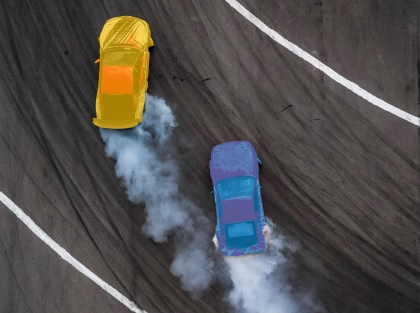‘How do consumers make decisions?’ – that is the million-dollar question. As eye movements play the central role in visual processing, one way to approach this question would be by investigating the findings from eye tracking studies.
Obviously, when consumers need to acquire information about choice alternatives and make comparisons, they need to direct their attention toward the plethora of flashy packages and pay attention to the stimulus features that are relevant for their choice.
Eye tracking therefore offers a way to trace the sequence of information processing throughout the course of the decision-making process.
The Role of Vision
Perhaps you know the ‘invisible gorilla’ test, (if you haven’t, we recommend watching this video now) where people are told to count how many times a ball is thrown between people, and as a result, they fail to notice a person in a gorilla suit passing the stage.
This perceptual phenomenon is called ‘change blindness’, and according to some authors, the reason why we fail to notice changes in visual scenes is because the visual system only perceives the information that is necessary for the immediate task [1].
In natural behavior, the main purpose for our eye movements is to accumulate sensory evidence to efficiently carry out actions [2]. One way we do this is by using fixations to lower the demands on working memory [3, 4]. For example, when standing in front of a supermarket shelf, we do not learn and remember all the information about all the products, but instead carry out fixations to make multiple comparisons, and mentally organize suitable options into consideration sets.
In other words, we decrease working memory demands and increase attention by carrying out more fixations, meaning that during the decision-making process, we rely on the use of fixations as external memory space [3-5].

The Consumer Choice Process
Numerous studies on preference-based decision-making have found a significant gaze bias toward the option that was ultimately chosen.
For example, when participants had to choose between six branded items, the chosen item was gazed at for a longer duration and more frequently, even when task motivation and time pressure were manipulated [7]. This is an example of top-down processing affecting our visual attention.
Do we naturally look more at the options we prefer, or is it the act of looking that makes us prefer these alternatives? Several models, such as the Gaze Cascade model [8] and the Attentional Drift Diffusion model [9] are based on the premise that gaze allocation has a causal effect on choice.
However, other authors have shown that the gaze bias effect occurs also in decisions that are not preference-based [10] and that we can form preferences without looking at the specific option [11]. Therefore the causal link between looking and choosing is at least more complex than previous models have suggested.
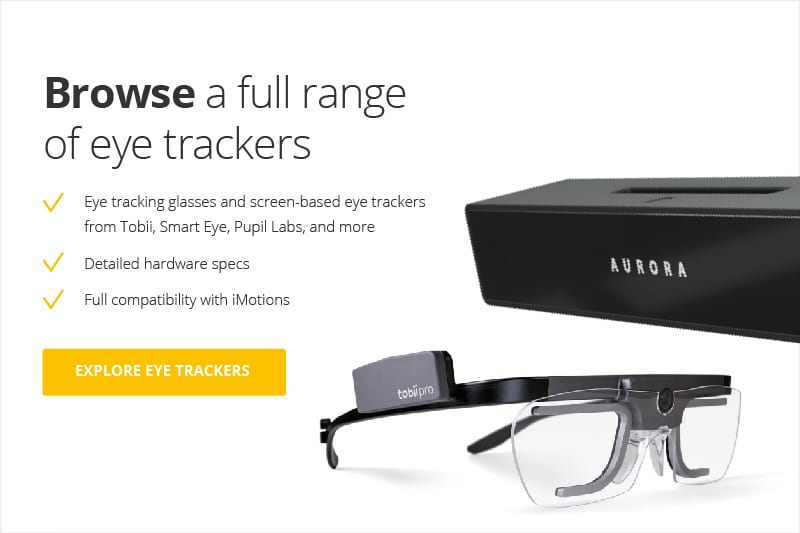
Product Appearance
Factors such as the product packaging surface size and position have also been shown to impact consumers’ visual attention and choice. For example, packaging with more facings attract more visual attention [17], and that in turn improves the likelihood that the brand is considered for purchase [18].
Different studies have also documented the viewers’ tendency to look more at the options placed near the center of the display, and this central position effect has been found to apply for both screen-based [6] as well as tangible product displays [17], [19].
Furthermore, it has also been shown that salient packages are more likely to capture visual attention, which in turn has a positive impact on choice [14]. The effect of saliency, however, is generally smaller than that of top-down control, as top-down factors such as task instructions, object representations, and semantic cues have been shown to override the attentional capture by saliency [15].
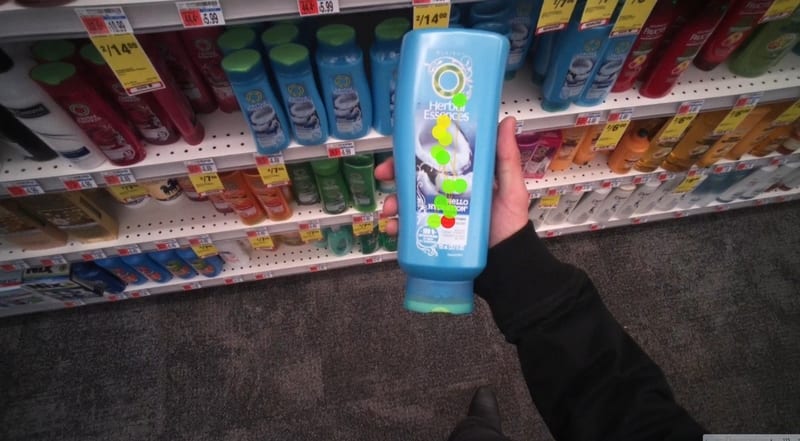
Focusing on object appearances / representations (rather than saliency) could help to explain why certain shelf areas, higher number of facings, or unusual package shapes are more likely to capture attention. These are all examples of features that activate visual attention through bottom-up processing.
In their review of studies on eye movements and choice, Orquin and Mueller Loose (2013) postulate that bottom-up attention capture is important because it acts a gatekeeping mechanism – package designs that are not attended are also excluded from the consideration set [5].
Along the same lines, it has been shown that former selective attention to a product improves its likelihood of being chosen, as the ease of processing contributes to preference formation [16]. The impact of stimulus-based features on choice, therefore, occurs in accordance with the mere exposure effect [5].
Top-down Influences and Attentional Phases
In the context of consumer decisions, goal-oriented or top-down attentional processes also play an important role. Not only do we allocate more attention to the options that are in alignment with our subjective preferences and consumption-related goals, but factors such as time pressure and the amount of alternatives also influence our viewing behavior.
More specifically, as the number of alternatives increases, decision-makers become more selective in terms of what they look at [22]. Increase in the number of options and time pressure also lead to shorter fixations and relatively smaller amount of information attended to [6], [7]. Thus, it is not surprising that consumers only look at a small subset of options available on supermarket shelves – ranging from around 25% [23] to 40% [17] of all items in the category.
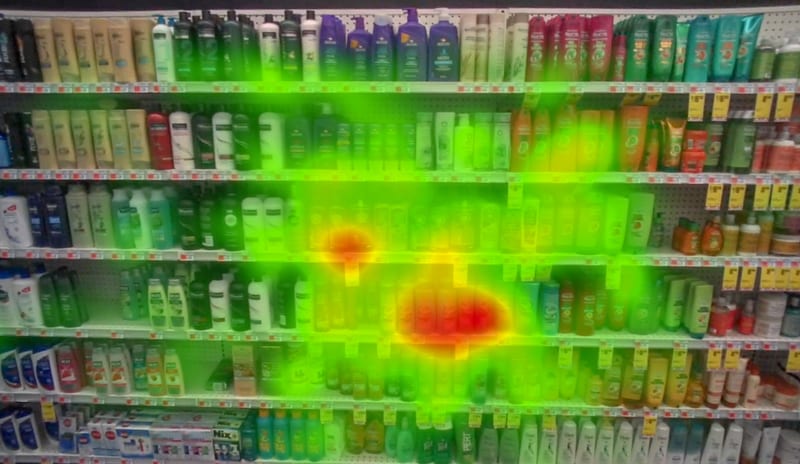
Glaholt and Reinglod (2009) suggest that biases in dwell duration and dwell frequency may reflect different processes over the course of decision making. More specifically, longer dwell durations may indicate that the decision-maker is encoding stimuli according to their relevance to the goal, whereas higher dwell frequency may be reflective of an active comparison across alternatives [10].
It has also been proposed that consumers frequently switch between different information acquisition strategies, such as product-based and attribute-based information acquisition. Before switching the strategy, consumers limit their attention to only two or three attributes or products, and sometimes reconsider the alternatives that were previously excluded [26]. Other studies have also noted that decision makers often use pairwise or three-way comparisons [24], [27], possibly due to the working memory constraints.
What these studies seem to indicate is that we do use fixations to lower the demands on our working memory, and strategically direct our gaze toward a choice alternative when its features are needed for the decision task. As eye movements are a manifestation of visual processing, studies employing eye tracking therefore have a great potential to further improve our understanding of cognitive processes that underlie complex choice processes.
What Can We Conclude?
There is no doubt that visual attention plays a crucial role in consumer decision making, or as the saying goes, “Unseen is unsold”. However, there is no simple formula – the final choice emerges a result of complex interactions among stimuli, attention processes, working memory, and preferences [5].
While consumers preferentially attend to options that are in alignment with their goals, stimulus-based features play a role in determining which options are more likely to be included in the consideration set. Display features such as the number of facings and shelf position, but also the saliency and shape of packages impact the likelihood of the product being fixated, which turn can a have downstream effect on choice.
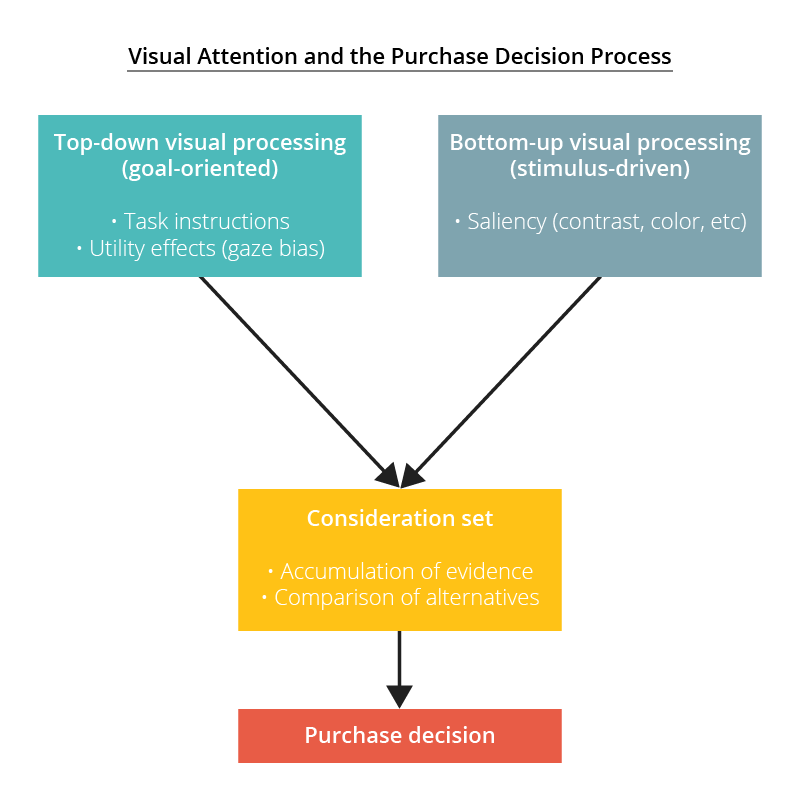
As the number of alternatives increases, consumers become more selective in terms of what they pay attention to. In supermarkets they only attend to a small subset of all available alternatives, and fixate on products to acquire goal-relevant information and make pairwise or three way comparisons.
A plausible explanation for such viewing behavior may be that consumers maintain cognitive efficiency by permitting reduced decision accuracy in order to lower the demands on attention and working memory. However, neither economic nor saliency models appear to definitively account for human visual choice processes, so we have to keep on exploring – more research with eye tracking is yet to be done.
To read more about how eye tracking research can help us understand consumer choice and decision making, download our free guide to eye tracking below:
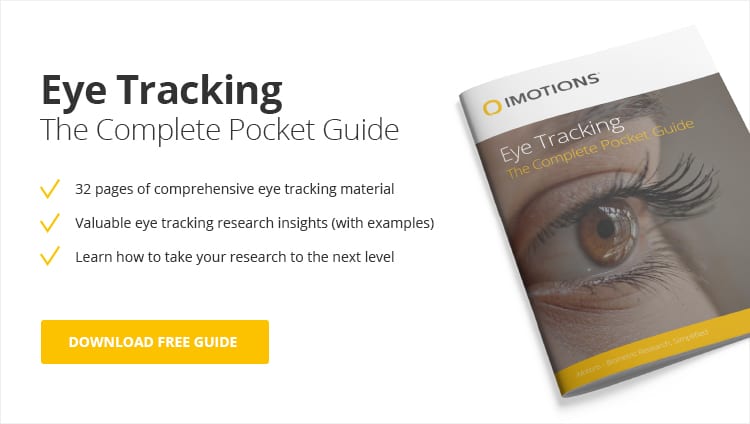
References
[1] M. Hayhoe, “Vision using routines: A functional account of vision” Vis. cogn., vol. 7, no. 1–3, pp. 43–64, 2000.
[2] B. W. Tatler, M. M. Hayhoe, M. F. Land, and D. H. Ballard, “Eye guidance in natural vision: Reinterpreting salience” J. Vis., vol. 11, no. 5, pp. 1–23, 2011.
[3] J. A. Droll and M. M. Hayhoe, “Trade-offs between gaze and working memory use” J. Exp. Psychol. Hum. Percept. Perform., vol. 33, no. 6, p. 1352, 2007.
[4] M. M. Hayhoe, D. G. Bensinger, and D. H. Ballard, “Task constraints in visual working memory” Vision Res., vol. 38, no. 1, pp. 125–137, 1998.
[5] J. L. Orquin and S. Mueller Loose, “Attention and choice: A review on eye movements in decision making” Acta Psychol. (Amst)., vol. 144, no. 1, pp. 190–206, 2013.
[6] E. Reutskaja, R. Nagel, C. F. Camerer, and A. Rangel, “Search dynamics in consumer choice under time pressure: An eye-tracking study” Am. Econ. Rev., vol. 101, no. 2, pp. 900–926, 2011.
[7] R. Pieters and L. Warlop, “Visual attention during brand choice: The impact of time pressure and task motivation” Int. J. Res. Mark., vol. 16, no. 1, pp. 1–16, 1999.
[8] S. Shimojo, C. Simion, E. Shimojo, and C. Scheier, “Gaze bias both reflects and influences preference” Nat. Neurosci., vol. 6, no. 12, p. 1317, 2003.
[9] I. Krajbich, D. Lu, C. Camerer, and A. Rangel, “The attentional drift-diffusion model extends to simple purchasing decisions” Front. Psychol., vol. 3, p. 193, 2012.
[10] M. G. Glaholt and E. M. Reingold, “Stimulus exposure and gaze bias: A further test of the gaze cascade model” Attention, Perception, Psychophys., vol. 71, no. 3, pp. 445–450, 2009.
[11] G. D. Bird, J. Lauwereyns, and M. T. Crawford, “The role of eye movements in decision making and the prospect of exposure effects” Vision Res., vol. 60, pp. 16–21, 2012.
[12] J. Clement, T. Kristensen, and K. Grønhaug, “Understanding consumers’ in-store visual perception: The influence of package design features on visual attention” J. Retail. Consum. Serv., vol. 20, no. 2, pp. 234–239, 2013.
[13] V. H. M. Visschers, R. Hess, and M. Siegrist, “Health motivation and product design determine consumers’ visual attention to nutrition information on food products” Public Health Nutr., vol. 13, no. 7, pp. 1099–1106, 2010.
[14] M. Milosavljevic, V. Navalpakkam, C. Koch, and A. Rangel, “Relative visual saliency differences induce sizable bias in consumer choice” J. Consum. Psychol., vol. 22, no. 1, pp. 67–74, 2012.
[15] E. Kowler, “Eye movements: The past 25 years” Vision Res., vol. 51, no. 13, pp. 1457–1483, 2011.
[16] C. Janiszewski, A. Kuo, and N. T. Tavassoli, “The influence of selective attention and inattention to products on subsequent choice” J. Consum. Res., vol. 39, no. 6, pp. 1258–1274, 2012.
[17] K. Gidlöf, A. Anikin, M. Lingonblad, and A. Wallin, “Looking is buying. How visual attention and choice are affected by consumer preferences and properties of the supermarket shelf” Appetite, vol. 116, pp. 29–38, 2017.
[18] P. Chandon, J. W. Hutchinson, E. T. Bradlow, and S. H. Young, “Does in-store marketing work? Effects of the number and position of shelf facings on brand attention and evaluation at the point of purchase” J. Mark., vol. 73, no. 6, pp. 1–17, 2009.
[19] A. S. Atalay, H. O. Bodur, and D. Rasolofoarison, “Shining in the center: Central gaze cascade effect on product choice” J. Consum. Res., vol. 39, no. 4, pp. 848–866, 2012.
[20] D. Walther and C. Koch, “Modeling attention to salient proto-objects” Neural networks, vol. 19, no. 9, pp. 1395–1407, 2006.
[21] M. Wischnewski, A. Belardinelli, W. X. Schneider, and J. J. Steil, “Where to look next? Combining static and dynamic proto-objects in a TVA-based model of visual attention” Cognit. Comput., vol. 2, no. 4, pp. 326–343, 2010.
[22] M. G. Glaholt, M.-C. Wu, and E. M. Reingold, “Evidence for top-down control of eye movements during visual decision making” J. Vis., vol. 10, no. 5, p. 15, 2010.
[23] K. Gidlöf, A. Wallin, R. Dewhurst, and K. Holmqvist, “Using eye tracking to trace a cognitive process: Gaze behaviour during decision making in a natural environment” J. Eye Mov. Res., vol. 6, no. 1, 2013.
[24] J. E. Russo and F. Leclerc, “An eye-fixation analysis of choice processes for consumer nondurables” J. Consum. Res., vol. 21, no. 2, pp. 274–290, 1994.
[25] J. Clement, “Visual influence on in-store buying decisions: an eye-track experiment on the visual influence of packaging design” J. Mark. Manag., vol. 23, no. 9–10, pp. 917–928, 2007.
[26] S. W. Shi, M. Wedel, and F. G. M. Rik Pieters, “Information acquisition during online decision making: A model-based exploration using eye-tracking data” Manage. Sci., vol. 59, no. 5, pp. 1009–1026, 2013.
[27] M. G. Glaholt and E. M. Reingold, “Eye movement monitoring as a process tracing methodology in decision making research” J. Neurosci. Psychol. Econ., vol. 4, no. 2, p. 125, 2011.




